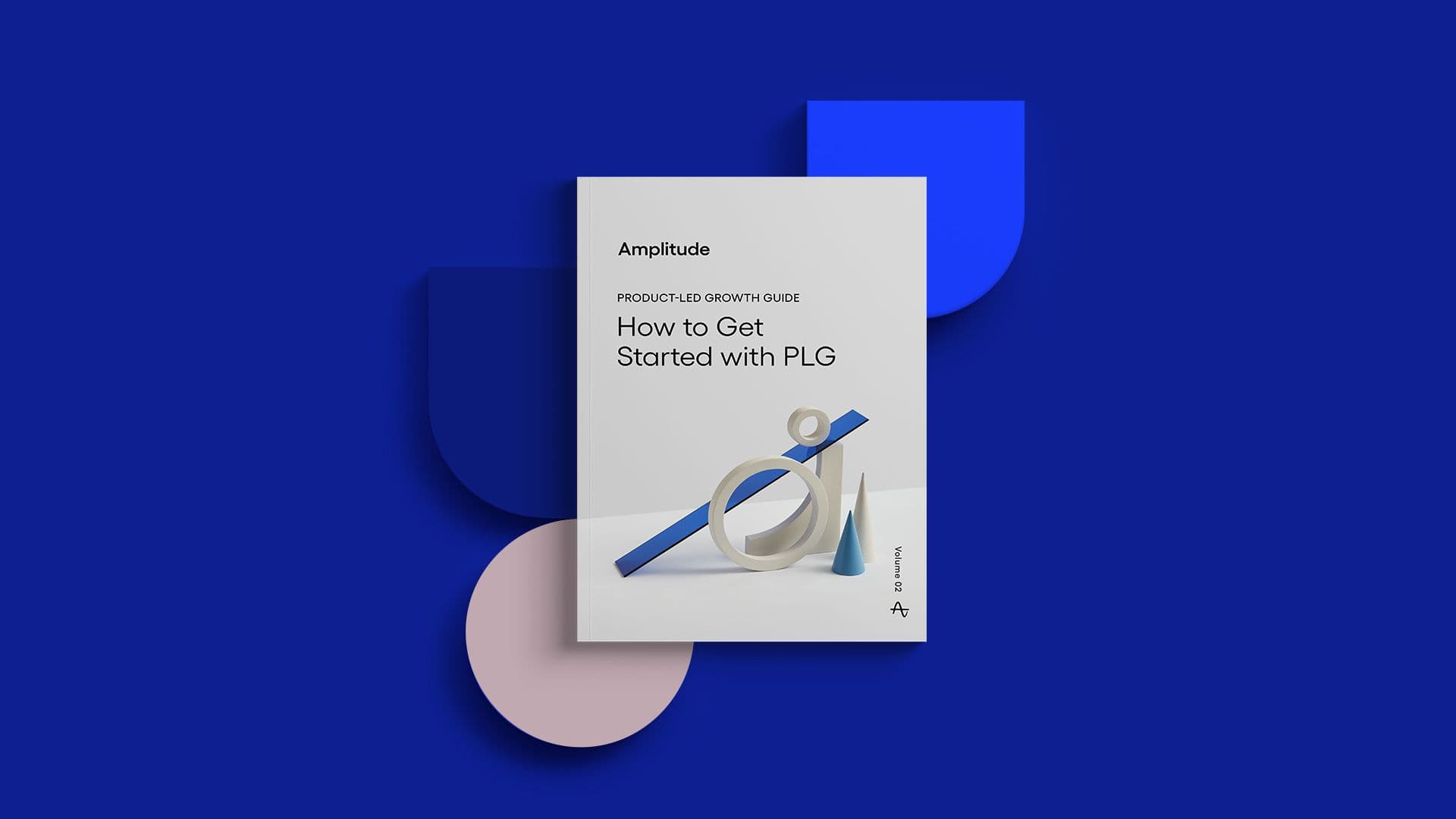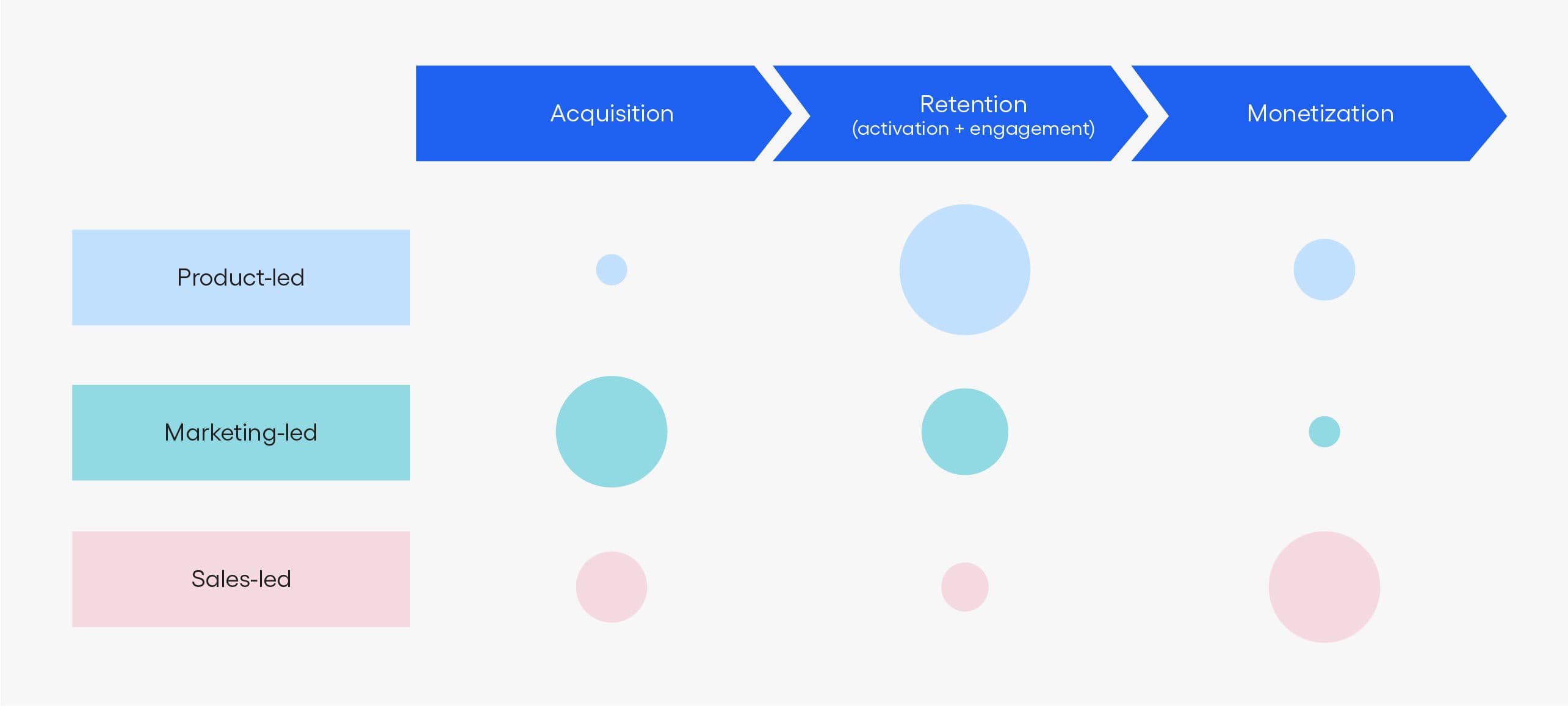From Strategy to Practice: Tactics and Metrics for Implementing PLG
We asked more than 30 experts for advice on implementing product-led growth. This is what they had to say.
This blog post highlights key themes from Product-Led Growth Guide Volume 2: How to Get Started with PLG. Download the full guide to take your PLG strategy to the next level.
If you read the first volume of our Product-Led Growth (PLG) Guide, you know PLG is here to stay. You also know that understanding the strategy and its nuances can be challenging.
Spoiler alert: the same is true for putting it into practice.
To help you get started, we’ve asked more than 30 industry experts about the tactics and metrics you can use to tackle PLG at your organization.
Key Takeaways
- PLG is a growth motion powered by the product that spans the entire customer journey—acquisition, retention (activation and engagement), and monetization.
- At the acquisition stage, the product is key to adding new users.
- For retention, the product guides users to discover its value on their own (activation), and product use becomes a habit (engagement).
- Monetization involves self-service purchases, often with trial or freemium approaches.
- Product metrics gauge how users interact with your product at each customer journey stage.
Read the full guide to see what product-led tactics drive acquisition, retention, and monetization—and which metrics to track for each stage.
What is PLG?
Former Amplitude Head of Growth Elena Verna describes growth as “your ability to predictably,
sustainably, and competitively answer the question of how you acquire, retain, and monetize customers.”
PLG is one way to do that. It’s a growth motion across each stage of the customer journey—acquisition, retention (activation and engagement), and monetization—with the product at the center:
- At the acquisition stage, the product drives new users to sign up.
- When it comes to retention, users activate and engage without any human intervention.
- At the monetization stage, users can check out without help from sales.
What are PLG tactics?
Each growth motion—product-led, sales-led, or marketing-led—has different tactics for each customer journey stage. You can, and often should, use them in tandem to drive acquisition, retention, and monetization.
Most companies blend product-led, marketing-led, and sales-led motions across the customer journey stages with different weights for each.
Product-led acquisition tactics
Even at this earliest stage of your customer journey, the product itself is key. Its inherent value—and shareability—animates one of the most popular product-led acquisition tactics: virality loops, the phenomenon of continuous customer referrals. These referrals may come through:
- Word-of-mouth: Loyal users who spread the word thanks to delightful product experiences.
- Incentives: Rewards or bonuses for users who invite their friends or teammates.
- Collaboration invitations: Built-in sharing mechanisms to help users bring others into the product to collaborate with them.
- Sharing experiences: Easy ways for users to share their in-product creations with people outside the product.
Products that leverage network effects become more valuable as more users adopt them. That’s because they make the most of connections between users—the network—offering more ways to communicate and collaborate.
Similarly, product artifacts—byproducts of software development that include diagrams or tools—can be a powerful means of attracting new users.
Content is another critical PLG acquisition tactic and can take different forms. These include editorial and support content your business creates to showcase the product's value or help users get started, such as guides, blog posts, or white papers.
Another effective form is programmatic content, a method for generating multiple web pages from one set of core content, using data and pre-programmed rules that dynamically transform the content based on the reader or goal. Ben Williams, former VP of Product at cybersecurity company Snyk and current Product-Led Geek Advisor, noted that Snyk’s programmatic content “brought in large volumes of users into the core use case for the product.”
Kyle Poyar, Operating Partner at OpenView and Growth Unhinged Author, also advocates for pairing SEO and content. In his product-led marketing guide, he cited tactics such as benchmark reports and product education.
Often, users generate—and sometimes even distribute—the most valuable content. One frequently cited example of user-generated content is SurveyMonkey, the platform that enables users to create and share surveys, generating new users for SurveyMonkey.
Product-led retention tactics
PLG is more than a strategy to attract new users: It’s also an effective way to keep them coming back. That’s why it’s so useful for retention—the result of activation and engagement.
Product-led activation tactics
For activation, the product guides users to discover its value on their own—and that might happen long before someone uses your product.
Williams recommends guiding users to find value and establish habits with the following tactics:
- Foster good friction. Eliminate bad friction but cultivate good friction through tactics like gamification, profiling questions, and personalized onboarding.
- Leverage social proof and use cases. Demonstrating how your product solves problems for customers with similar use cases can help you relate to new users and improve trust.
- Chart user progress. Visualizing user progress during the onboarding phase can be a powerful motivator, inspiring users to complete the process and unlock the product’s full value.
Another effective way to drive activation is by awarding users skills certifications for completing trainings, which encourages other users to increase their own engagement.
Amplitude VP of Product Ibrahim Bashir cites certifications as a way to reward power users by turning their usage into something beneficial to them.
Product-led engagement tactics
When it comes to engagement, it’s a matter of making product use become a habit. Williams pointed to such tactics as:
- Push notifications that remind users to return to the product
- Game mechanics that motivate users to stick with the product by rewarding them with a sense of accomplishment
- Personalized experiences that align with users’ needs and expectations
- Communities where users can exchange advice and ideas and find a sense of belonging that brings them back to the product
- Incentives that entice users to come back to the product
- Integrations that give users more reasons to leverage the product
- In-app messages or marketing content that informs users of how they can maximize the product
Product-led monetization tactics
With PLG, the road to monetization begins long before users type their credit card numbers into a checkout page.
Verna points to trial-based, freemium, or reverse-trial models as tactics for turning new users into paying ones.
- Trial-based models offer a version of a paid product for a limited time. After the trial ends, the customer pays or must stop using the product. There are two kinds of trials:
- Credit card trials, which require a credit card number upfront that is automatically charged when the trial ends.
- Free trials, which enable customers to use the product without providing payment information.
- Freemium models offer a limited version of the product for free, forever. The customer may upgrade to a paid plan to access additional features, more usage, or special benefits like priority support.
- Reverse-trial models put customers in a freemium experience with a limited-time, free trial with access to paid capabilities. The experience reverts to a traditional freemium plan after the free trial ends.
Although their approaches vary, what these models have in common is a way of offering users a chance to experience the product before committing.
Other useful monetization tactics include:
- Use case awareness. Williams discussed highlighting paywalled features that unlock different use cases.
- Product-led sales. Product usage signals (e.g., usage spikes, advanced feature usage, or user behavior changes) let GTM teams know when to engage with a customer.
- Pricing updates. Because PLG takes a land-and-expand approach with free or low-cost entry plans that fill a pipeline of users for later conversion to enterprise deals, finding the lowest sustainable price is essential.
Use this cheat sheet to keep track of product-led tactics across the customer journey. See the full list, including marketing-led and sales-led tactics, in Product-Led Growth Guide Volume 2.
How to measure PLG tactics
Once you employ any of these tactics, you’ll want to know if they’re working—and quantify their impact. Enter product metrics, which show how users interact with your product. Your team can use these metrics to better understand what users find helpful, what keeps them coming back, and the best way to take them on a successful journey to becoming loyal customers.
These metrics align with the customer journey stages: acquisition, retention (activation and engagement), and monetization.
- Acquisition metrics, such as the number of new signups and qualified leads, cost of acquisition, and payback period, measure when someone starts using your product or service.
- Activation metrics, including the activation rate and time to activate, show you how well you are moving users from acquisition through that critical “aha” moment, where they discover why your product is valuable to them and, in turn, provide value to your business.
- Engagement metrics, like monthly active users and feature usage, measure how (and how often) users interact with your product. Users who engage with your product are considered active users.
- Retention metrics, such as retention rate, free-to-paid conversions, and churn rate, gauge how many users return to your product over a certain period. These are critical metrics for your company’s growth.
- Monetization metrics—net revenue retention, monthly recurring revenue, and average revenue per user—capture how well your product is turning engagement into revenue.
Drive growth with products customers love
Read the full guide to learn how to tackle PLG with these product-led tactics and metrics—and discover how Amplitude and other businesses put them into action to achieve real results.
In the guide:
- Proven methods for driving acquisition, retention, and monetization
- The tactics and metrics Amplitude uses internally for our PLG motion
- Success stories from businesses across a variety of industries and sizes
Get your copy of Product-Led Growth Guide Volume 2: How to Get Started with PLG today.

Ashley Stepien
Former VP of Marketing, Amplitude
Ashley is a marketing and growth leader, formerly serving as the VP of Marketing at Amplitude and advisor to several tech companies. Previously, she was VP of Marketing at Ramp and Webflow.
More from Ashley






